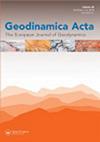土耳其南部安塔利亚推覆体中二叠世火山作用的发现:构造意义和全球意义
IF 1.5
Q1 Earth and Planetary Sciences
引用次数: 16
摘要
对中上二叠世Tahtalıdağ推覆体(安塔利亚推覆体)的岩石进行了详细的地层学研究,揭示了在浅海化石碳酸盐岩序列中穿插玄武岩火山岩的存在。在Kızılbağ组中产生明显枕状的玻璃质玄武岩挤压物使伴生的碳酸盐岩严重白云化。同一时期的Çukurköy组,没有火山层,也暴露在同一走廊中,可能代表了与火山活动相邻的碳酸盐台地的一部分。根据有孔虫分带对Kızılbağ组和Çukurköy组的中-上二叠统进行了标定,并确定了玄武岩层段的capitian年龄。玄武岩在年代地层上也位于被解释为capitanian中期大灭绝事件的地平线下方。基于这些数据,本研究可以得出两个基本结论。玄武岩火山活动的发现为安塔利亚推覆构造中与裂谷相关的火山事件的更长的历史提供了强有力的证据。Capitanian火山岩与中国南方峨眉山大火成岩省同生,与Capitanian中期大灭绝事件有关。本文章由计算机程序翻译,如有差异,请以英文原文为准。
Discovery of Middle Permian volcanism in the Antalya Nappes, southern Turkey: tectonic significance and global meaning
Detailed stratigraphic studies on the Middle-Upper Permian rocks of the Tahtalıdağ nappe (Antalya Nappes), largely exposed along the Güzelsu Corridor in central Taurides, have revealed the presence of basaltic volcanic rocks intercalated within the shallow-marine fossiliferous carbonate successions. Vitrophyric basaltic extrusions producing distinct pillows in the Kızılbağ Formation severely dolomitized the associated carbonate rocks.The coeval Çukurköy Formation, devoid of volcanic layers, is also exposed in the same corridor and was probably representing a part of the carbonate platform bordering this volcanic activity. The Middle-Upper Permian successions of the Kızılbağ and Çukurköy Formations have been calibrated based on a foraminiferal zonation and a Capitanian age has been assigned to the basaltic interval. Basalts are also chronostratigraphically located just below a horizon interpreted as the mid-Capitanian mass extinction event. Based on these data, two fundamental conclusions can be driven from this study. The discovery of basaltic volcanism brings a strong evidence for a much longer history about the rift-associated volcanic events in the Antalya Nappes. The Capitanian volcanic rocks are contemporaneous with the Emeishan Large Igneous Province in South China which is linked to the mid-Capitanian mass extinction event.
求助全文
通过发布文献求助,成功后即可免费获取论文全文。
去求助
来源期刊

Geodinamica Acta
地学-地球科学综合
CiteScore
4.50
自引率
0.00%
发文量
0
审稿时长
25 weeks
期刊介绍:
Geodinamica Acta provides an international and interdisciplinary forum for the publication of results of recent research dealing with both internal and external geodynamics. Its aims to promote discussion between the various disciplines that work on the dynamics of the lithosphere and hydrosphere. There are no constraints over themes, provided the main thrust of the paper relates to Earth''s internal and external geodynamics. The Journal encourages the submission of papers in all fields of earth sciences, such as biostratigraphy, geochemistry, geochronology and thermochronology, geohazards and their societal impacts, geomorphology, geophysics, glaciology, igneous and metamorphic petrology, magmatism, marine geology, metamorphism, mineral-deposits and energy resources, mineralogy, orogeny, palaeoclimatology, palaeoecology, paleoceanograpgy, palaeontology, petroleum geology, sedimentology, seismology and earthquakes, stratigraphy, structural geology, surface processes, tectonics (neoteoctonic, plate tectonics, seismo-tectonics, Active tectonics) and volcanism.
Geodinamica Acta publishes high quality, peer-reviewed original and timely scientific papers, comprehensive review articles on hot topics of current interest, rapid communications relating to a significant advance in the earth sciences with broad interest, and discussions of papers that have already appeared in recent issues of the journal. Book reviews are also included. Submitted papers must have international appeal and regional implications; they should present work that would be of interest to many different specialists. Geographic coverage is global and work on any part of the world is considered. The Journal also publishes thematic sets of papers on topical aspects of earth sciences or special issues of selected papers from conferences.
 求助内容:
求助内容: 应助结果提醒方式:
应助结果提醒方式:


